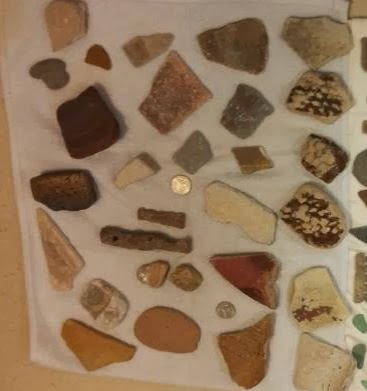Written by the TreasureGuide for the exclusive use of treasurebeachesreport.blogspot.com.
 |
| Fossil Shark Teeth and Pot Shard Finds by Eva S. |
A few days ago I posted a note from Eva S. who has been finding fossils and shards on the beaches between Sebastian and Vero. Here are a few of her finds. (Many more are shown below.)
That is the kind of thing you are likely to find these days. I'm sure the detecting snow birds, who are on the Treasure Coast in great numbers now, are disappointed with the beach detecting conditions. Since our good detecting back in November conditions have been consistently on the poor side.
You just can't control beach conditions. You have to adapt and make the best of it. Another alternative is to take a little trip.
Yesterday I talked about abandoned and hidden beaches. Some were not ideal beaches to begin with. I'm thinking of some of those that you'll find in parks where they tried to make a nice beach on a lake, bay or stream by bringing in nice white sand and and spreading it. That usually doesn't last long. The weeds will come up right through the new sand and nature will reclaim the beach. I can think of a few like that. Beaches like that might look nice at first but they aren't used much by people because the area just beyond the dumped sand is still muddy or mucky in the shallow water. The result being that they give up on maintaining the beach before long and it is reclaimed by nature. You can identify those beaches by the unnatural white sand on one part of the shoreline.
I can think of one abandoned beach inside the property of a very large Florida amusement park. At one time there was a life guard station and dock at that beach. Now you can hardly tell there was ever a beach there. I first detected that one when it was in full operation. Now it is very over grown, there is no sign of the life guard station and the dock is gone.
I'm still working on uploading my video clips of how objects move on a beach. No success yet. I also plan to make more videos and do some experiments to illustrate the processes of beach dynamics.
A few notes on Florida history follows.
Between 1513 and 1565 at least eight Spanish expeditions were sent to Florida with the aim of establishing Spanish rule.
In 1565 Menendez massacred 130 people at Fort Caroline, a French outpost near Jacksonville. Nine days later he led the killing of 110 more Frenchmen near St. Augsutine, inspiring the name of Mantanzas (massacre) Inlet.
It appears that Europeans had been to Florida before Ponce de Leon. Many believe that John Cabot (Giovanni Caboto) was the first European to see Florida.
Several maps appear to show Florida years before its supposed discovery by Ponce de Leon.
They include the Juan de la Cosa Map, published in 1500.
The 1507 Waldseemuler Map that is housed in the Library of Congress and appears to show the peninsula of Florida.
And the Peter Martyr Map, which was circulating in Europe as early as 1511, two years before Ponce's supposed discovery of the area.
More than one hundred Florida missions were established by the Franciscans and the Jesuits beginning in 1566. By 1705 they had all disappeared.
All of this is in J. D.Allman's book on Florida history that I referred to back a ways.
On the Treasure Coast the surf is increasing a little for a couple of days. It looks like it will be up to about four feet or so.
The wind will be out of the south and southeast, so if anything, expect beach building.
Below are a number of photos of pieces that Eva has picked up along the beach. You can look through them and see if you can help with identifying anything that might be older or interesting. Note in the last photo, the couple of wooden handles, for example.
Here goes.
Happy hunting,
TreasureGuide@comcast.net
A few notes on Florida history follows.
Between 1513 and 1565 at least eight Spanish expeditions were sent to Florida with the aim of establishing Spanish rule.
In 1565 Menendez massacred 130 people at Fort Caroline, a French outpost near Jacksonville. Nine days later he led the killing of 110 more Frenchmen near St. Augsutine, inspiring the name of Mantanzas (massacre) Inlet.
It appears that Europeans had been to Florida before Ponce de Leon. Many believe that John Cabot (Giovanni Caboto) was the first European to see Florida.
Several maps appear to show Florida years before its supposed discovery by Ponce de Leon.
They include the Juan de la Cosa Map, published in 1500.
The 1507 Waldseemuler Map that is housed in the Library of Congress and appears to show the peninsula of Florida.
And the Peter Martyr Map, which was circulating in Europe as early as 1511, two years before Ponce's supposed discovery of the area.
More than one hundred Florida missions were established by the Franciscans and the Jesuits beginning in 1566. By 1705 they had all disappeared.
All of this is in J. D.Allman's book on Florida history that I referred to back a ways.
On the Treasure Coast the surf is increasing a little for a couple of days. It looks like it will be up to about four feet or so.
The wind will be out of the south and southeast, so if anything, expect beach building.
Below are a number of photos of pieces that Eva has picked up along the beach. You can look through them and see if you can help with identifying anything that might be older or interesting. Note in the last photo, the couple of wooden handles, for example.
Here goes.
Happy hunting,
TreasureGuide@comcast.net






